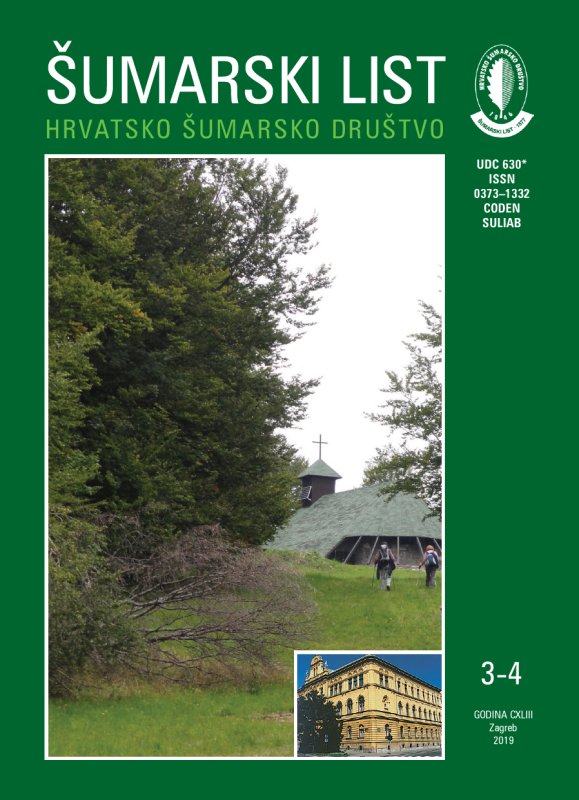
broj: 3-4/2019
pdf (8,59 MB) |
|
||||||||||||||
| RIJEČ UREDNIŠTVA | ||
| Uredništvo | ||
| Establishing yet another study of forestry in Croatia pdf HR EN | 101 | |
| IZVORNI ZNANSTVENI ČLANCI | ||
| Jelena Kranjec Orlović, Ivan Andrić, Ida Bulovec, Danko Diminić | UDK 630*443 (001) https://doi.org/10.31298/sl.143.3-4.1 | |
| Mycobiota in the seeds of narrow-leaved ash (Fraxinus angustifolia Vahl) pdf HR EN | 103 | |
| Ida Katičić Bogdan, Davorin Kajba, Saša Bogdan | UDK 630* 232.3 (001) https://doi.org/10.31298/sl.143.3-4.2 | |
| Variability of clones in acorn production and its effect on effective population sizes and genetic diversity of crops in clonal seed orchards of pedunculate oak (Quercus robur L.) in Croatia pdf HR EN | 111 | |
| Marilena Idžojtić, Igor Anić, Ivan Šimić, Maja Anastazija Kovačević, Igor Poljak | UDK 630* 174(001) https://doi.org/10.31298/sl.143.3-4.3 | |
| Dendrological characteristics of the Trsteno Arboretum pdf HR EN | 125 | |
| PRETHODNO PRIOPĆENJE | ||
| Mladen Zadravec, Toni Koren, Boris Lauš, Ivona Burić, Barbara Horvatić | UDK 630* 419 https://doi.org/10.31298/sl.143.3-4.4 | |
| Preliminary data on the beetle (Coleoptera) fauna of Turopoljski Lug forest pdf HR EN | 145 | |
| Summary Wetlands provide many important ecosystem services, e.g. serving as natural retention areas to prevent flooding and they can be recreational areas for the general public. They also represent vital habitats for many animal species and many are protected nature areas. In spite of this, the fauna of many wetlands in Croatia is still mostly unknown, especially when it comes to beetles. Not knowing the fauna of a particular habitat hinders management efforts. One such location is Turopoljski Lug forest, south-east from the capital Zagreb. The fieldwork was done from March till September 2017, utilising four methods: sweep netting, baited traps on tree trunks, light trapping with UV light traps at night, and collecting by hand. Additionally, several records from earlier visits are included. The total number of currently known species for the forest is raised from 51 to 133. A total of nine species are near threatened (NT), seven of which are saproxylic. Three species listed in Annexes II and IV of the Habitats Directive occur in the area, of which only Cerambyx cerdo had been recorded. Additionally, a neglected literature record of a fourth, Phryganophilus ruficollis, has been discovered. Current management practices for the forest should be re-evaluated and modified if necessary. Future research targeting specific beetle groups should yield further increases in the number of species known for the area, while a targeted mapping of the distribution of species listed on the Annexes should yield much-needed conservation information. Key words: flooded forest; Natura 2000 Ecological Network; Cerambyx cerdo; Phryganophilus ruficollis; Trox perrisii; nature protection areas | ||
| Kenan Zahirović, Tarik Treštić, Azra Čabaravdić, Mirza Dautbašić , Osman Mujezinović | UDK 630* 443 https://doi.org/10.31298/sl.143.3-4.5 | |
| Causitive agents of decay of norway spruce /Picea abies (L.) Karst./ on the mountain Zvijezda pdf HR EN | 155 | |
| Martin Bobinac, Siniša Andrašev, Andrijana Bauer-Živković, Nikola Šušić | UDK 630* 561 https://doi.org/10.31298/sl.143.3-4.6 | |
| Growth elements of the trees and the stand of Gymnocladus dioicus (L.) K. Koch at Fruška gora (Serbia) pdf HR EN | 161 | |
| PREGLEDNI ČLANCI | ||
| Zdenko Franić | UDK 630*892 https://doi.org/10.31298/sl.143.3-4.7 | |
| Apiforestry – beekeeping and forestry pdf HR EN | 171 | |


